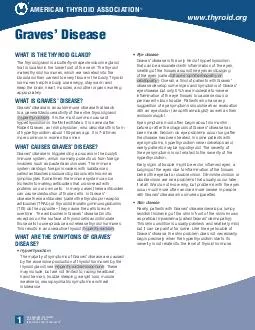

Although many patients with Graves disease have redness and irritation of the eyes at some time less than five percent ever develop enough inflammation of the eye tissues to cause serious or permanent trouble Patients who have more than very mild ey ID: 10671
Download Pdf The PPT/PDF document "Graves Disease This page and its content..." is the property of its rightful owner. Permission is granted to download and print the materials on this web site for personal, non-commercial use only, and to display it on your personal computer provided you do not modify the materials and that you retain all copyright notices contained in the materials. By downloading content from our website, you accept the terms of this agreement.
AMERICAN THYROID ASSOCIATIONThis page and its contents are Copyright © 2017the American Thyroid Association www.thyroid.org This page and its contents are Copyright © 2017the American Thyroid Association www.thyroid.org HOW IS THE DIAGNOSIS OF GRAVES’ The diagnosis of hyperthyroidism is made on the basis of your symptoms and ndings during a physical exam and it is con rmed by laboratory tests that measure the amount of thyroid hormones (thyroxine, or T4, and triiodothyronine, or T3) and thyroid-stimulating hormone Hyperthyroidism brochure). Clues that your hyperthyroidism is caused by Graves’ disease are the presence of Graves’ eye disease and/or dermopathy (see above), a symmetrically enlarged thyroid gland and a history of other family members with thyroid or other autoimmune problems, including type 1 diabetes, rheumatoid arthritis, pernicious anemia (due to lack of vitamin B12) or painless white patches on the skin known The choice of initial diagnostic testing depends on cost, availability and local expertise. Measurement of antibodies, such as TRAb or TSI, is cost effective and if positive, con rms the diagnosis of Graves’ disease without further testing needed. If this test is negative (which can also occur in some patients with Graves’ disease), or if this test is not available, then your doctor should refer you to have a radioactive iodine uptake test (RAIU) to con rm the diagnosis. Also, in some patients, measurement of thyroidal blood ow with ultrasonography may be useful to establish the diagnosis if the above tests are not readily available.HOW IS GRAVES’ DISEASE TREATED?The treatment of hyperthyroidism is described in detail in Hyperthyroidism brochure. All hyperthyroid patients should be initially treated with beta-blockers. Treatment options to control Graves’ disease hyperthyroidism include antithyroid drugs (generally methimazole [Tapazole®], although propylthiouracil [PTU] may be used in rare instances such as the rst trimester of pregnancy), radioactive iodine and surgery. Antithyroid medications are typically preferred in patients who have a high likelihood of remission (women, mild disease, small goiters, negative or low titer of antibodies). These medications do not cure Graves’ hyperthyroidism, but when given in adequate doses are effective in controlling the hyperthyroidism. If methimazole is chosen, it can be continued for 12-18 months and then discontinued if TSH and TRAb levels are normal at that time. If TRAb levels remain elevated, the chances of remission are much lower and prolonging treatment with antithyroid drugs is safe and may increase chances of remission. Long term treatment of hyperthyroidism with antithyroid drugs may be considered in selected cases. If your hyperthyroidism due to Graves’ disease persists after 6 months, then your doctor may recommend de nitive treatment with either radioactive iodine or surgery. If surgery (thyroidectomy) is selected as the treatment modality, the surgery should be performed by a skilled surgeon with expertise in thyroid surgery to reduce the risk of complications. Your doctor should discuss each of the treatment options with you including the logistics, bene ts and potential side effects, expected speed of recovery and costs. Although each treatment has its advantages and disadvantages, most patients will nd one treatment plan that is right for them. Hyperthyroidism due to Graves’ disease is, in general, controllable and safely treated and treatment is almost always successful. WHAT WILL BE THE OUTCOME OF TREATMENT?If you receive de nitive treatment for your Graves’ hyperthyroidism (such as radioactive iodine or surgery), you will eventually develop hypothyroidism (underactive thyroid). Even if you are treated with antithyroid drugs alone, hypothyroidism can still occur. Your doctor will thyroid function tests frequently to assess thyroid function following treatment. When hypothyroidism occurs, you will need to take a thyroid hormone tablet Hypothyroidism brochureOTHER FAMILY MEMBERS AT RISKGraves’ disease is an autoimmune disease and has a genetic predisposition. However, no speci c gene has been identi ed for screening to date. AMERICAN THYROID ASSOCIATION FURTHER INFORMATIONFurther details on this and other thyroid-related topics are available in the patient thyroid information section on the American Thyroid Associationwww.thyroid.orgFor information on thyroid patient support organizations, please visit the Patient Support Links section on the ATA website at www.thyroid.org